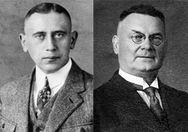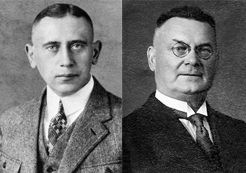Asia
EMEA
Hofmann’s successors
Synthetic rubber only grew in importance as it was discovered how to form chain molecules from rubber modules – such as Hofmann’s methyl-isoprene – more quickly and effectively. The addition of sodium into the mix made this possible. In the 1920s, Hofmann’s successors succeeded in using this metal and numerous processing tricks to create a different synthetic rubber from butadiene, a “simpler” chemical formulation from the natural rubber module isoprene. This product went down in history as “Buna” – a name coined from its constituents, butadiene and sodium (Na).
The next step was taken soon after by the chemists Walter Bock and Eduard Tschunkur. Bock in particular was responsible for combining butadiene with another highly promising module – styrene. This gave rise to the “styrene rubber” Buna S, which – in a much evolved form – remains a key component in car tires today. The patent for the copolymerization of butadiene and styrene was awarded on June 21, 1929.
This period also saw the development of another rubber from Leverkusen that became popular – the nitrile rubber Buna N, invented by the chemists Eduard Tschunkur, Helmut Kleiner and Erich Konrad. A patent for this new, oil-repellent rubber was awarded on April 26, 1930. After 1938, this remarkable elastomer was marketed under the name Perbunan, to distinguish it more clearly from Buna S.
Gradually, the chemical industry introduced more and more varieties of rubber to the market, all exhibiting new technical properties. Along with these came countless innovations in the field of rubber chemicals, which are essential for manufacturing rubber, including antioxidants (antidegradants) and vulcanization accelerators, such as Vulkanox and Vulkacit. Chemists and technicians from LANXESS have played key roles in many of these developments.
- Gallery



